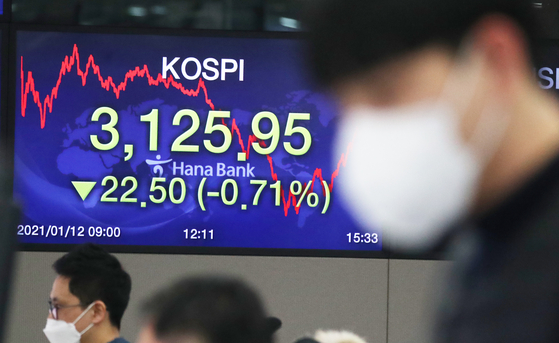From the outward appearance, the domestic stock market is an unprecedented boom. Kospi, which stepped on Hill 3000 in the New Year, broke 3100 degrees on the 8th (closed price). Although he has been breathing for the second day due to the recent short-term surge, the decline is not significant. On the 12th, the KOSPI closed the market at 3125.95, down 0.71% (22.5 points) from the previous day. It fell more than 3% during the intraday and was pushed to 3047.56, but it kept the 3100 line against the momentum of individual investors who started to buy a net purchase of 2,310 billion won.

On the afternoon of the 12th, the KOSPI index fell 22.50 points (-0.71%) to 3125.95 on the display board of Hana Bank’s dealing room in Myeong-dong, Jung-gu, Seoul. News 1
6 out of 10 KOSPI stocks fell
But there is also a dark shadow behind it. As some stocks, such as Samsung Electronics, have led the share price to rise, the phenomenon of’rich rich poor poor rich’ is becoming more pronounced. In the stock market, the’K-shape polarization’, which has a large temperature difference between the upper and lower necks, appears. It is the’KOSPI Divide (Gap)’ that only the big ones are good at.
The JoongAng Ilbo commissioned the Korea Exchange to analyze the fluctuation rate of 908 KOSPI-listed stocks (excluding 10 stocks suspended from trading) from December 23 to 11 last year when the KOSPI rose in earnest. There were 375. That’s 41.3% of the total. Shinpoong Paper (-35%), Daewoong Pharmaceutical (-29.6%), Meritz Fire & Marine Insurance (-10.7%), and IBK (-7.1%) are representative.
Although the KOSPI continues its new record march and celebrates day after day, investors who have bought these stocks have not been able to eat the fruit.
Even at the rate of increase, the polarization is severe. Although 6 out of 10 stocks made profits, the situation is different compared to the overall increase rate of KOSPI (15.2%). Only 133 (14.6%) stocks exceeded the KOSPI increase rate. These include SK Innovation (61.5%), LG Electronics (54%), Hyundai Motors (45.4%), Samsung SDI (31.5%), and Samsung Electronics (25.9%).

Looking at the fluctuation rate of all KOSPI stocks. Graphic = Reporter Cha Junhong [email protected]
Transportation equipment increased by 30%, banks decreased by 6.8%
Even if we look at each company size, the polarization is remarkable. The large-cap index, consisting of stocks ranked 1st to 100th in market cap, rose 17.6% over the same period. On the other hand, mid-cap stocks (items 101-300 in market cap) and small-cap stocks (items below 301 in market cap) rose only 5.3% and 3.7%, respectively.
Heebi is also mixed by industry. In addition to the 30.2% jump in the transportation equipment index, including automakers, due to Hyundai Motor’s sprint, electricity and electronics (25.1%), manufacturing (19%), and chemicals (15.5%) exceeded the KOSPI growth rate, but banks (-6.8%) ·Paper wood (-5.9%), electric gas (-0.9%), and textile clothing (-0.2%) were rather negative.

Large stocks rise more. Graphic = Reporter Cha Junhong [email protected]
Samsung Securities’ investment information team leader Jung Myung-ji explained, “Unlike the past, the fact that individual investors bought large stocks mainly caused the polarization of the stock price.” Individual investors have net purchases of 5.8 trillion won in the KOSPI market since the 23rd of last month, of which Samsung Electronics bought 3.95 trillion won worth of purchases. This is 68% of the total net purchase.
“It seems that familiarity with large companies such as Samsung Electronics and Hyundai Motors, a sense of psychological stability, and trust that it will grow in the mid- to long-term, etc.,” Jeong said. In addition, recent good news, such as the rumor of cooperation with Apple (Hyundai Motors) and anticipation of a semiconductor’super cycle’ (Samsung Electronics), also met.
As such, the share of the high-ranking KOSPI market capitalization in the market is increasing. As of the 11th, the total market capitalization of the top 10 KOSPI market caps (excluding preferred stocks) was 1048.68 trillion won, accounting for 48.3% of the total KOSPI market (2172 trillion 871 billion won). It is a figure that has risen close to 3 percentage points from 45.4% on the 22nd of last month.

Polarization by industry. Graphic = Reporter Cha Junhong [email protected]
“Panic buying, no debts”
Experts predict that stock prices will continue to polarize by stock in the stock market. “After the novel coronavirus infection (Corona 19), all industries are not developing evenly, but they are moving toward a’K-shaped recovery’,” said Jung Yong-taek, head of IBK Investment & Securities Research. Investment will be concentrated in batteries, etc.,” he said.
However, it is not advisable to invest blindly in these stocks. Kiwoom Securities’ investment strategy team leader Seo Sang-young said, “It is the right direction to buy large stocks rather than small and medium-cap stocks or theme stocks.”
Reporter Hwang Eui-young [email protected]
